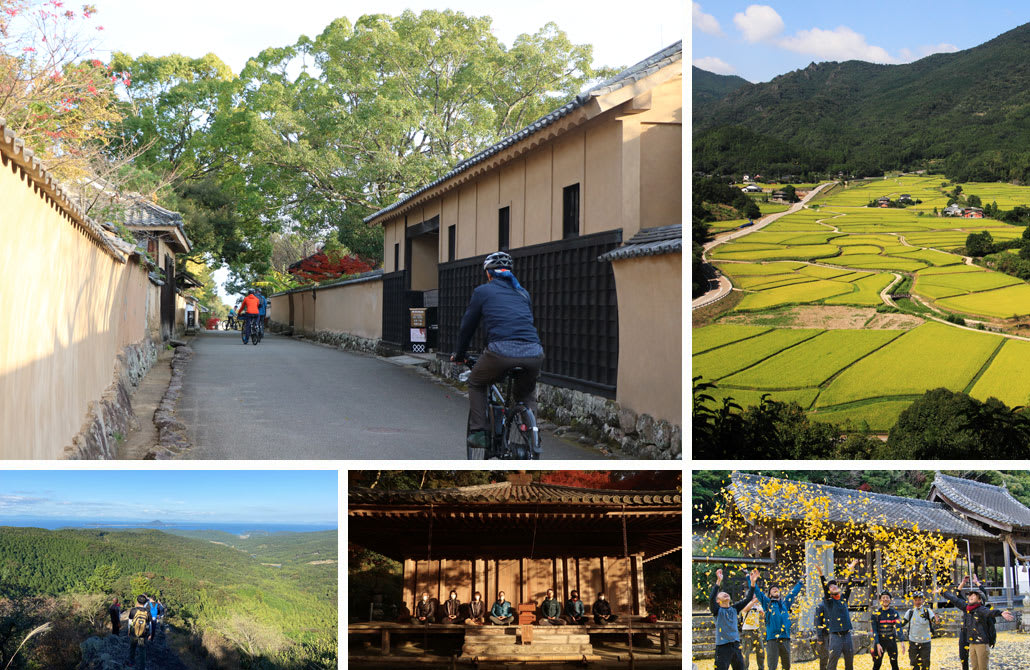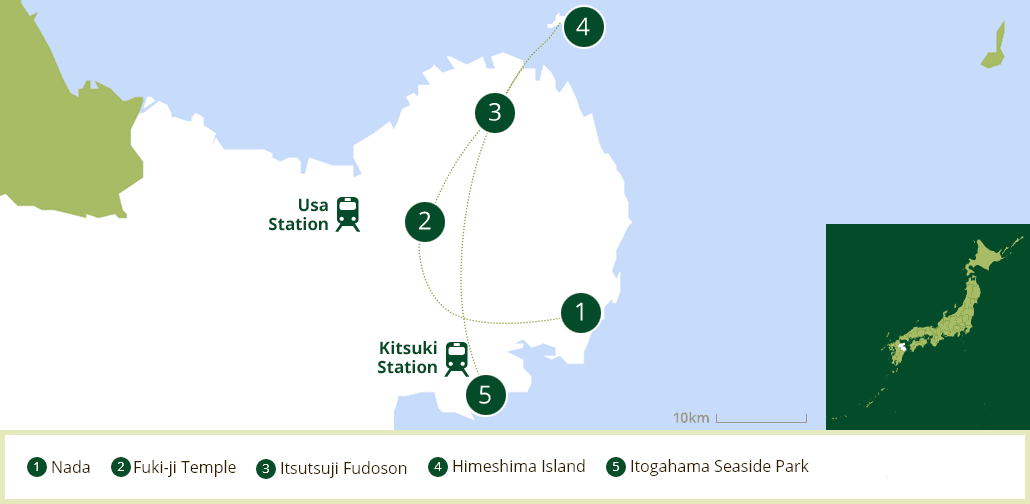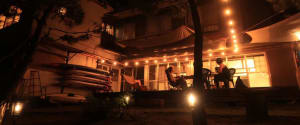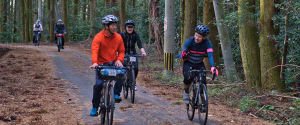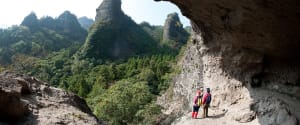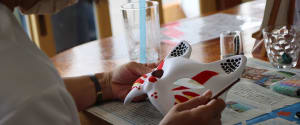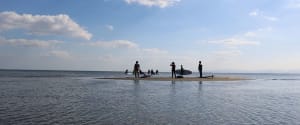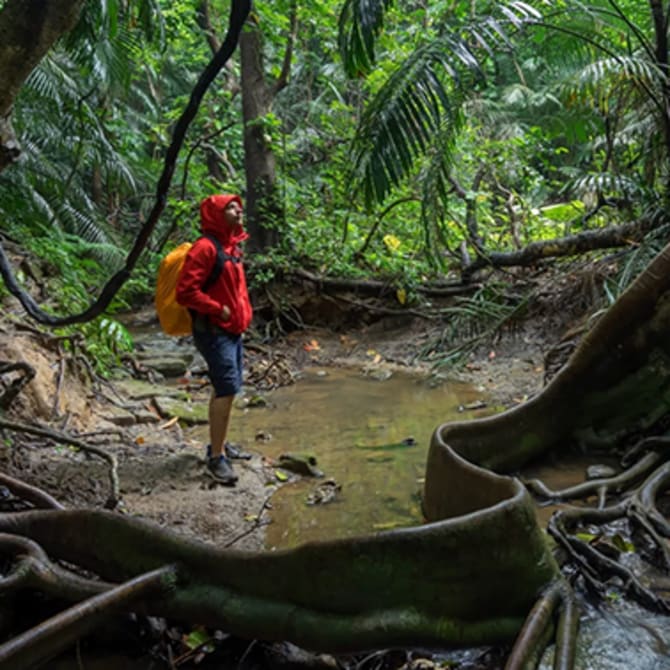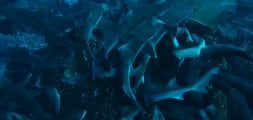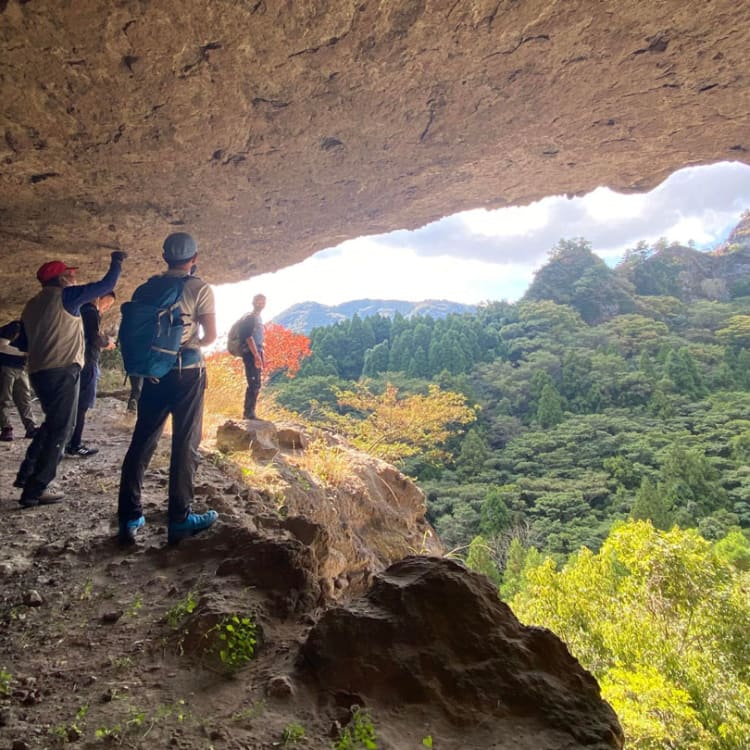
Recommended Route Kyushu (Oita)
Day 1
Introduction: Where the journey begins
On the first day of our journey of discovering the culture and nature of the Kunisaki Peninsula , you will have an orientation briefing on your itinerary at the guesthouse run by the tour guide. This is the best time for you to ask any questions about your stay. After the orientation briefing, a welcome party will be held in the form of a dinner that features the use of local ingredients. This will a great opportunity to get to know your fellow travelers. After spending some time together, it’s time to rest up in preparation for the adventure that will begin the following day.
Day 2
Cycling along Niorindo, a historical and cultural heritage route on the Kunisaki Peninsula
On the second day, wake up a little early and head to Nada Beach to catch the sunrise. The combination of the morning glow washing over the horizon, the stunning beach, and the Hachiman Nada Shrine torii gate floating above the surface of the sea evoke a pensive atmosphere. After a delicious breakfast, take a moment to pray for a safe trip at the Hachiman Nada Shrine and start the day in good spirits.
After checking out of your accommodation, a shuttle bus will take you to the start of the Niorindo cycling route. Traveling along this 38-kilometer route will bring you a closer look at the histories and traditions of the region that have been passed down over a millennium, from the early modern period to medieval times.
The first stop will be the castle town of Kitsuki Castle , which has prospered since its construction in 1394. The unique sight of rows of traditional-style buildings and beautiful stone pavements built on the uneven terrain surrounded by rivers and seas has been preserved in its original form since the Edo period. Besides strolling around the area, you can also enjoy Japanese tea at a long-established teahouse that has been in business for over 280 years and look for souvenirs at the Kitsuki Furusato Industry Hall.
After leaving Kitsuki, head north to Tashibunosho , which is located in inland Kunisaki Peninsula . The vast rural landscape of this area that took shape during the Heian and Kamakura periods has been preserved almost exactly in its original form. For lunch, you can food on a charcoal grill using charcoal from Tashibuno while interacting with members of the local women’s association.
In the afternoon, visit the historic sites of Rokugo Manzan, a unique mountain worship faith that had flourished on the Kunisaki Peninsula around 1,300 years ago. You will also make an especially memorable visit to Maki Odo, which houses as many as nine Buddha statues that are all nationally designated Important Cultural Properties.
For your second night, you will stay at Ryoan Fukinotou, located on the temple grounds of the Fuki-ji Temple, the final stop on the Niorindo cycling tour as well as the last historic site on the historical tour learning about the Rokugo Manzan culture. The accommodation facility is akin to a lodging house run by the family of the temple’s head priest, where you can enjoy heartwarming, family-style hospitality in a quiet and relaxing environment. For dinner, you will have handmade soba noodles made with buckwheat grown in Bungo Takada alongside farmhouse dishes that feature a wide variety of different vegetables. Finally, you can immerse yourself in a natural hot spring to relieve your fatigue and recharge for the next day.
After checking out of your accommodation, a shuttle bus will take you to the start of the Niorindo cycling route. Traveling along this 38-kilometer route will bring you a closer look at the histories and traditions of the region that have been passed down over a millennium, from the early modern period to medieval times.
The first stop will be the castle town of Kitsuki Castle , which has prospered since its construction in 1394. The unique sight of rows of traditional-style buildings and beautiful stone pavements built on the uneven terrain surrounded by rivers and seas has been preserved in its original form since the Edo period. Besides strolling around the area, you can also enjoy Japanese tea at a long-established teahouse that has been in business for over 280 years and look for souvenirs at the Kitsuki Furusato Industry Hall.
After leaving Kitsuki, head north to Tashibunosho , which is located in inland Kunisaki Peninsula . The vast rural landscape of this area that took shape during the Heian and Kamakura periods has been preserved almost exactly in its original form. For lunch, you can food on a charcoal grill using charcoal from Tashibuno while interacting with members of the local women’s association.
In the afternoon, visit the historic sites of Rokugo Manzan, a unique mountain worship faith that had flourished on the Kunisaki Peninsula around 1,300 years ago. You will also make an especially memorable visit to Maki Odo, which houses as many as nine Buddha statues that are all nationally designated Important Cultural Properties.
For your second night, you will stay at Ryoan Fukinotou, located on the temple grounds of the Fuki-ji Temple, the final stop on the Niorindo cycling tour as well as the last historic site on the historical tour learning about the Rokugo Manzan culture. The accommodation facility is akin to a lodging house run by the family of the temple’s head priest, where you can enjoy heartwarming, family-style hospitality in a quiet and relaxing environment. For dinner, you will have handmade soba noodles made with buckwheat grown in Bungo Takada alongside farmhouse dishes that feature a wide variety of different vegetables. Finally, you can immerse yourself in a natural hot spring to relieve your fatigue and recharge for the next day.
Day 3
The Kunisaki Hantou Minemichi Long Trail: Ascending the sacred mountains where Shugendo (mountain asceticism) practitioners used to make their journey
Wake up early at the temple to take part in a Zen meditation session under the guidance of the temple’s vice head priest in the solemn space of the main hall, part of which has been designated as a National Treasure, before having breakfast.
After breakfast, leave Fuki-ji Temple by a shuttle bus and head for the starting point of the Kunisaki Hantou Minemichi Long Trail, the highlight of your itinerary. This trail comprises a set of trekking routes centered on the Rokugo Manzan Mineirigyo, an ancient form of mountain asceticism practiced in this area. This time, you will be taking a route based on the K-1 route, the most popular route of the 10 different routes available. There will be many beautiful encounters along the 9-kilometer route, which takes 6 to 7 hours to complete on foot.
By noon, you will pass by checkpoints along the route such as Saihoji Village, Ofuji Iwaya, Amidagoe, and Ofudo Iwaya. After navigating a steep mountain path, you will arrive at Ofudo Iwaya, where a huge crack in the quay offers spectacular views of the mountainside lined with rocks of all kinds of unusual shapes. Take a break here and enjoy the eco-friendly bento box made with local ingredients.
In the afternoon, continue on the route and pass by Shiritsuki Iwaya, the present Sendo-ji Temple as well as its former site, and Itsutsuji Fudoson, before arriving at your final destination of Fudojaya. The views from Itsutsuji Fudoson, built on the rock surface of a cliff 365 meters above sea level, are absolutely breathtaking. On sunny days, you may even see as far as Himeshima and Yamaguchi Prefecture across the sea. If you’d like, you can also have the head priest conduct the Goma fire ritual for you at Itsutsuji Fudoson.
At the end of the trail, a shuttle bus will take you to Imi Port, where you will board a ferry to Himeshima via Himeshima Port. Spend the night at Pension Nojigiku, the owner who is a fisherman will prepare dinner using kurumaebi (Japanese tiger prawns), a Himeshima local specialty, and other seafood that he has caught himself.
After breakfast, leave Fuki-ji Temple by a shuttle bus and head for the starting point of the Kunisaki Hantou Minemichi Long Trail, the highlight of your itinerary. This trail comprises a set of trekking routes centered on the Rokugo Manzan Mineirigyo, an ancient form of mountain asceticism practiced in this area. This time, you will be taking a route based on the K-1 route, the most popular route of the 10 different routes available. There will be many beautiful encounters along the 9-kilometer route, which takes 6 to 7 hours to complete on foot.
By noon, you will pass by checkpoints along the route such as Saihoji Village, Ofuji Iwaya, Amidagoe, and Ofudo Iwaya. After navigating a steep mountain path, you will arrive at Ofudo Iwaya, where a huge crack in the quay offers spectacular views of the mountainside lined with rocks of all kinds of unusual shapes. Take a break here and enjoy the eco-friendly bento box made with local ingredients.
In the afternoon, continue on the route and pass by Shiritsuki Iwaya, the present Sendo-ji Temple as well as its former site, and Itsutsuji Fudoson, before arriving at your final destination of Fudojaya. The views from Itsutsuji Fudoson, built on the rock surface of a cliff 365 meters above sea level, are absolutely breathtaking. On sunny days, you may even see as far as Himeshima and Yamaguchi Prefecture across the sea. If you’d like, you can also have the head priest conduct the Goma fire ritual for you at Itsutsuji Fudoson.
At the end of the trail, a shuttle bus will take you to Imi Port, where you will board a ferry to Himeshima via Himeshima Port. Spend the night at Pension Nojigiku, the owner who is a fisherman will prepare dinner using kurumaebi (Japanese tiger prawns), a Himeshima local specialty, and other seafood that he has caught himself.
Day 4
From Himeshima, the Setting of Japan’s Creation Myths, to Beppu, a Prominent Hot Spring area
For the fourth day, spend plenty of time sightseeing on Himeshima before departing the island in the evening. Discover more about the history and romantic vibes of Himeshima, a place that is often referenced in Japanese mythology, as well as the island’s culture and way of life.
After breakfast, take a walk along the Himeshima Blue Line, a scenic route along the coastline stretching from the eastern part to the southern part of the island, following which you will move on to the first activity of the day, the Himeshima Kitsune Odori mask-painting workshop. The Himeshima Kitsune Odori is a unique Bon festival dance that has evolved in this area since the Kamakura period and is held every year from August 14th to 16th. Participants can personally paint the masks inspired by the Kitsune Odori (fox dance) with their own original designs and bring them home as souvenirs.
Next up is a lunchtime activity where you will make imokiri, a local dish of Himeshima.
Imokiri is a dish unique to Himeshima, where sweet potatoes have been a staple food as the land here is not ideal for growing rice. These noodles are made by drying thinly sliced sweet potatoes into a powder called kankoro powder, which is then kneaded with water and cut into thin noodles that have a subtle sweetness and a chewy texture. You can look forward to interacting with the elderly residents of the island while making imokiri from scratch and enjoying the dish together.
In the afternoon, embark on the Hime no Hosomichi trekking route that traverses three mountains on Himeshima: Darumayama, Shiroyama, and Yahazudake. This 3-hour, 7-kilometer trek will allow you to discover the magnificent and mysterious nature of Himeshima, which has also been registered as a Japan Geopark.
The starting point of this trek is Kannonzaki, a scenic spot featuring a 40 meter-high and 120 meter-long obsidian quay. At the top of this formation is a small hall called Sennindo that enshrines the Kannonzaki, one of the Seven Wonders of Himeshima. The next stop is the habitat of the chestnut tiger butterfly. The chestnut tiger butterfly is a migratory species that travels from the Japanese archipelago to the Nansei Islands and as far as Taiwan, and it is known to fly back to Himeshima in the spring and fall. Awaiting you at the final destination is Yahazudake, the highest peak on Himeshima towering 267 meters above sea level. You can see the entire island from the observatory atop the mountain and enjoy beautiful views of Himeshima that you will not forget for a long time.
After that, you will make your way down the mountain to mark the end of the trek and take the ferry from Himeshima Port back to Imi Port, where you will transfer to a shuttle bus that takes you to the next destination, the Beppu hot spring area. The hot spring you will visit is Myoban Onsen, located at the highest altitude out of the eight hot springs in Beppu , with a serene atmosphere. This is a perfect place for you to experience the traditional hot spring healing culture and good old public bathhouses.
You will first have dinner upon arrival at the hot spring. Under the guidance of the hot spring inn’s proprietress, enjoy a local dish called “jigoku-mushi,” which makes use of the steam produced by the hot springs. You will also get to experience the traditional hot spring healing culture at the inn where you will be spending the night. If you wish, you can even visit the public bathhouses nearby to try various hot springs and learn how to enjoy public baths to the fullest.
After breakfast, take a walk along the Himeshima Blue Line, a scenic route along the coastline stretching from the eastern part to the southern part of the island, following which you will move on to the first activity of the day, the Himeshima Kitsune Odori mask-painting workshop. The Himeshima Kitsune Odori is a unique Bon festival dance that has evolved in this area since the Kamakura period and is held every year from August 14th to 16th. Participants can personally paint the masks inspired by the Kitsune Odori (fox dance) with their own original designs and bring them home as souvenirs.
Next up is a lunchtime activity where you will make imokiri, a local dish of Himeshima.
Imokiri is a dish unique to Himeshima, where sweet potatoes have been a staple food as the land here is not ideal for growing rice. These noodles are made by drying thinly sliced sweet potatoes into a powder called kankoro powder, which is then kneaded with water and cut into thin noodles that have a subtle sweetness and a chewy texture. You can look forward to interacting with the elderly residents of the island while making imokiri from scratch and enjoying the dish together.
In the afternoon, embark on the Hime no Hosomichi trekking route that traverses three mountains on Himeshima: Darumayama, Shiroyama, and Yahazudake. This 3-hour, 7-kilometer trek will allow you to discover the magnificent and mysterious nature of Himeshima, which has also been registered as a Japan Geopark.
The starting point of this trek is Kannonzaki, a scenic spot featuring a 40 meter-high and 120 meter-long obsidian quay. At the top of this formation is a small hall called Sennindo that enshrines the Kannonzaki, one of the Seven Wonders of Himeshima. The next stop is the habitat of the chestnut tiger butterfly. The chestnut tiger butterfly is a migratory species that travels from the Japanese archipelago to the Nansei Islands and as far as Taiwan, and it is known to fly back to Himeshima in the spring and fall. Awaiting you at the final destination is Yahazudake, the highest peak on Himeshima towering 267 meters above sea level. You can see the entire island from the observatory atop the mountain and enjoy beautiful views of Himeshima that you will not forget for a long time.
After that, you will make your way down the mountain to mark the end of the trek and take the ferry from Himeshima Port back to Imi Port, where you will transfer to a shuttle bus that takes you to the next destination, the Beppu hot spring area. The hot spring you will visit is Myoban Onsen, located at the highest altitude out of the eight hot springs in Beppu , with a serene atmosphere. This is a perfect place for you to experience the traditional hot spring healing culture and good old public bathhouses.
You will first have dinner upon arrival at the hot spring. Under the guidance of the hot spring inn’s proprietress, enjoy a local dish called “jigoku-mushi,” which makes use of the steam produced by the hot springs. You will also get to experience the traditional hot spring healing culture at the inn where you will be spending the night. If you wish, you can even visit the public bathhouses nearby to try various hot springs and learn how to enjoy public baths to the fullest.
Day 5
Sup Cruising, Kaiseki Lunch, and a Castle Town Tour in Hijimachi
For the final day, take a walk through the hot spring resort town in the morning and take in the sight of steam rising from hot springs everywhere as well as the relaxing atmosphere of a therapeutic spa resort. Both private baths and public bathhouses are open from early in the morning, so make sure you take advantage of them.
After having breakfast and checking out, a shuttle bus will take you to Itogahama Seaside Park, which is located in the southern part of the Kunisaki Peninsula opposite Beppu Bay. The activity for the morning will be SUP cruising in Beppu Bay. This is the perfect time to catch some memorable views of the Kunisaki Peninsula , where you have traveled over the last few days, from the sea. The 3-hour, 4-kilometer route includes a short visit to a secret cave.
After the SUP cruising, make your way to Tekizanso, a mansion built in 1915 that is also a nationally designated important cultural property. This villa was built in Hijimachi by Hiroe Narikiyo, who had made his fortune by managing a gold mine that used to be in Kitsuki, and it now serves as the site of a Japanese restaurant. Enjoy an exquisite kaiseki lunch in this grand building. The garden of Tekizanso is also a stunning registered national monument that boasts picturesque views of Beppu Bay in the background.
Finally, take a stroll through the streets of Hiji, a town that has been affectionately called the “castle town of the sea” because of the way its landscape blends beautifully into Beppu Bay. As you enjoy magnificent views from the former site of Hiji Castle which was built facing the sea, the journey finally comes to an end as we reflect on the various encounters with the long history of the Kunisaki Peninsula over the last five days.
After having breakfast and checking out, a shuttle bus will take you to Itogahama Seaside Park, which is located in the southern part of the Kunisaki Peninsula opposite Beppu Bay. The activity for the morning will be SUP cruising in Beppu Bay. This is the perfect time to catch some memorable views of the Kunisaki Peninsula , where you have traveled over the last few days, from the sea. The 3-hour, 4-kilometer route includes a short visit to a secret cave.
After the SUP cruising, make your way to Tekizanso, a mansion built in 1915 that is also a nationally designated important cultural property. This villa was built in Hijimachi by Hiroe Narikiyo, who had made his fortune by managing a gold mine that used to be in Kitsuki, and it now serves as the site of a Japanese restaurant. Enjoy an exquisite kaiseki lunch in this grand building. The garden of Tekizanso is also a stunning registered national monument that boasts picturesque views of Beppu Bay in the background.
Finally, take a stroll through the streets of Hiji, a town that has been affectionately called the “castle town of the sea” because of the way its landscape blends beautifully into Beppu Bay. As you enjoy magnificent views from the former site of Hiji Castle which was built facing the sea, the journey finally comes to an end as we reflect on the various encounters with the long history of the Kunisaki Peninsula over the last five days.




















































